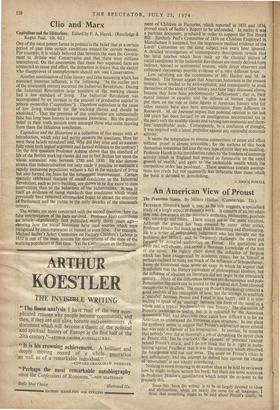An American View of Proust
The Proustian Vision. By Milton Hindus. (Cumberlege. 32s.)
PROFESSOR HINDUS'S book is not, as the title suggests, a specialised study of a single aspect Of Proust's work. It consists of an introdue• tion and five essays on the novelist's esthetics, philosophy, psychol- ogy, sociology and ethics. These essays are in the main excellent. Although the ground has been covered by many other critics, Professor Hindus has much to say that is interesting and illuminating. He is a writer of,independent judgement who has thought out the problemsfor- himself, and he frequently challenges the views put fom,Ard by accepted authorities on Proust. His quotations are trE% and well-chosen, and real a thorough knowledge of the text of the novel. He rightly plays down the influence of Bergson which has been exaggerated by academic critics, but he himself is perhaps inclined to make too much of the influence .of Schopenhauer. Remy de Gourmont once wrote an essay in which he argued that Symbolism was the literary equivalent of philosophical idealism, but the influence of idealism on literature did not begin in the nineteenth century. Many of the differences between pre-Renaissance and post. Renaissance literature can be traced to the gradual shift from classical metaphysics to idealism. The essay on Proust's psychology contains a good analysis of his conception of love, but the attempt to establish a 'parallel' between Proust and Freud is less happy, and it is mis- leading to speak of an 'analogy' between 'the form of the novel as a whole and a typical psychoanalytic case history.' The discussion of Proust's sociology is useful, but it is coloured by the American democratic bias, and illustrates once again how difficult it is for an American to understand the European class structure. In one place the professor seems to suggest that Proust's aristocracy never existed but was only a figment of his imagination. In another, he remarks that nobody 'ever did so thorough a job of debunking the upper class as Proust did,' but he overlooks the element of personal rancour behind Proust's attack, and I do not think that he is right in main- taining against Feuillerat that it was the aristocracy which absorbed the bourgeoisie and not vice versa. The essay on _Proust's ethics is less satisfactory, and the attempt to defend him against the charge of `amoralism' is not wholly convincing.
Nothing is more irritating to an author than to be told by reviewers how he ought to have written his book, but there are some sentences in Professor Hindus's,introduction which tempt the reviewer to do precisely this.
Since this book (he writes) is to be so largely devoted to ideas and abgtractions, which are nearly the same for all languages, I think that something ought to be said about Proust's quality in
French. It is to be noted as an interesting fact that his style, which seems to me the least debatable part of his equipment as an artist, has, from the first, been more heatedly discussed, argued and denied altogether than any other element of his work. I have seen the view expressed that C. K. Scott-Monerieff's translation is so much better and more lucid than the original that it should be translated back into French.
This is well said, and it needed saying. The truth is that 'the Proustian vision' is something much more than the sum of the 'ideas and abstractions' to which Professor Hindus devotes his book, and that it can only be reached through an analysis of his prose style. It is therefore unfortunatn that the professor should apparently have been diverted from his"proper aim by his countrymen's notorious ignorance of modern langJages, particularly as his short section on Proust's imagery shows that he was very well equipped for the task.
Until the close of the eighteenth century the French language was an extremely lucid, but also an extremely limited instrument of expression. During the nineteenth century it underwent the same process of expansion as other European languages in the seventeenth century. It was not simply that many new words were added— this happened in all languages—but that it acquired fresh powers of suggestion and a fresh subtlety. The process is easier to illustrate than to describe. I am one of the growing body of readers who admire Stendhal as a prince du langage, but when we compare the sober, colourless, unemphatic language in which he presents a psycho- pathic 'case' in, Armance with the botanical imagery used by Proust to introduce the theme of homosexuality in Sodome et Gomorrhe, we realise with a shock the immense increase which has taken place in the range of language and the gulf which separates modern French prose style from the classic style of the eighteenth century. This alteration in the quality of language reflects a growth of sensibility, a reaching out into unknown regions of experience. Proust has been called sin disciple de l'ancienne rhetorique. There are classic elements in his style, but he was also the heir of the age of Symbolism and Impressionism. It does not matter whether he is describing the rain beating on the windows, a shadow falling on a balcony, the dead lilacs at Combray or Swann's jealousy—he makes us feel that we are seeing all these things for the first time and invests them with a strange magic. That is the real meaning of 'the Proustian vision' whiph is also, simply, a new vision.
MARTIN TURNELL



































 Previous page
Previous page